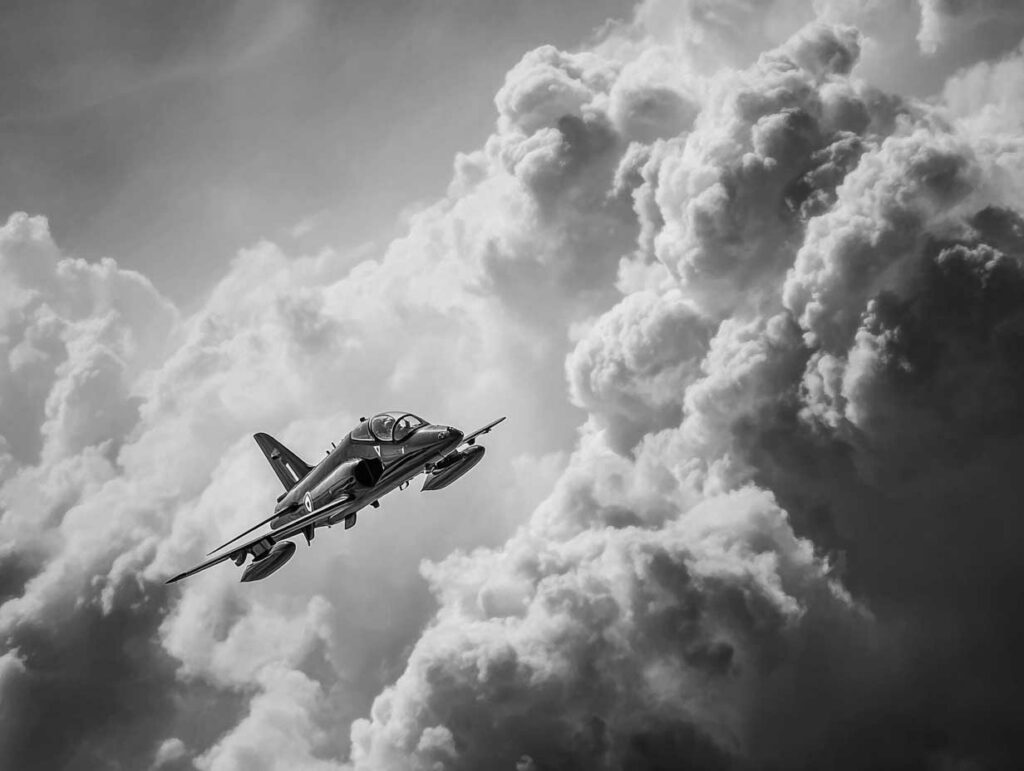
16 Jul RAF to Replace Hawk T1 and T2 with New Advanced Trainer Jet
The RAF launches a competition to replace Hawk T1 and T2 jets with a cost-effective training fighter jet, aiming to support jobs and modernise pilot instruction.
In July 2025, the UK Ministry of Defence confirmed the launch of a competition to replace the Royal Air Force’s aging Hawk T1 and T2 training aircraft. Used for advanced pilot instruction and by the Red Arrows aerobatic team, these jets are approaching obsolescence. The upcoming replacement seeks a cost-effective, next-generation training fighter jet capable of preparing pilots for fast jets like the Typhoon and the F-35. Among the contenders is Aeralis, proposing a modular light jet manufactured in Scotland. This programme aims to modernise RAF pilot training infrastructure while offering significant industrial and employment benefits. The selection process will focus on adaptability, lifecycle cost, and readiness for live and synthetic training integration. The outcome will shape how the UK prepares its future fighter pilots over the next three decades.
The Hawk legacy and the need for replacement
The Hawk T1 entered service in 1976 and has served as the RAF’s standard fast jet trainer for nearly 50 years. The T2, introduced in the 2000s, upgraded the platform with digital avionics and a glass cockpit. Together, they have trained generations of fighter pilots and supported the world-renowned Red Arrows aerobatic team. However, both aircraft are showing their age. Maintenance costs are increasing, availability is declining, and their systems no longer reflect the complexity of modern frontline aircraft.
The Strategic Defence Review concluded that continuing to invest in outdated platforms is no longer sustainable. A new training fighter jet is needed to bridge the gap between elementary flying training and operational conversion to combat aircraft such as the Typhoon and the F-35. This replacement must replicate modern sensor suites, information displays, and flight characteristics in a safe and cost-efficient environment.
Performance and capability requirements
The replacement for the Hawk must offer more than just flight training. It should be a full-spectrum training system capable of developing tactical skills, mission planning, and real-time data processing. Key requirements include high sortie rates, integration with live-virtual-constructive environments, and compatibility with both basic and advanced training modules.
Crucially, the aircraft must support the training of future fighter pilots who will operate in contested electromagnetic environments, with high levels of sensor fusion and data-link interoperability. It must also be suitable for aerobatic performance, as the Red Arrows require a highly manoeuvrable, visually distinct jet with tight control tolerances. Whether the RAF opts for a single platform to replace both the Hawk T1 and T2, or separates the display and training roles, remains under discussion.
Aeralis and the modular jet concept
A key British contender in the upcoming competition is Aeralis, a company proposing a revolutionary modular light jet. Unlike traditional aircraft built for a single purpose, the Aeralis concept is based on a common fuselage that can be fitted with different wings, engines, and systems. This allows the same aircraft to serve multiple roles, from basic jet training to advanced combat training and even aerobatic display.
Aeralis claims that this approach can reduce through-life costs by up to 50 percent compared to legacy platforms. It also simplifies logistics, as parts can be standardised across fleet variants. The design is supported by the RAF’s Rapid Capabilities Office and is seen as a potentially sovereign solution to the Hawk replacement challenge. Manufacturing is proposed at Prestwick Airport in Scotland, potentially supporting thousands of jobs across the aerospace supply chain.
Economic and industrial implications
Choosing a domestically developed training fighter jet could deliver significant economic benefits. Assembly and supply chain operations at Prestwick would revitalise British aerospace manufacturing, which has seen decades of contraction. The proposed site already benefits from aviation infrastructure and a skilled workforce, reducing the cost and complexity of industrial ramp-up.
A national solution would also strengthen defence resilience by ensuring that training aircraft, maintenance, and spare parts remain under UK control. This is especially important at a time when global supply chains are vulnerable to disruption. The Ministry of Defence has expressed support for UK-based proposals, though the final decision will balance performance, cost, and industrial strategy.
Potential competitors in the programme
While Aeralis represents an innovative British option, other global manufacturers are likely to bid. Leonardo’s M-346, Boeing’s T-7A Red Hawk, KAI’s T-50, and Turkey’s Hurjet are all proven advanced jet trainers with operational histories. These aircraft offer high levels of maturity and are already in use by allied air forces.
The UK must therefore choose between a low-risk, off-the-shelf acquisition or a high-potential but higher-risk domestic solution. The modular approach offered by Aeralis is unproven in service but aligns with future trends in military aviation, where adaptability and digital architecture matter as much as aerodynamic performance.
Training infrastructure and system integration
Replacing the aircraft is only part of the challenge. The next generation training system must include ground-based simulators, mission planning tools, data analytics, and synthetic training environments. Integration with radar ranges and secure communication networks will be essential to replicate operational conditions.
The new aircraft will need to be equipped with modern avionics, radar warning receivers, electronic warfare simulators, and data link systems to prepare pilots for the battlefield of tomorrow. The training environment must also evolve to deliver complex scenarios in multi-domain operations, including space and cyber dimensions.
Red Arrows considerations
The Red Arrows, as ambassadors of British aviation, will require a replacement aircraft that is visually distinctive, aerobatically agile, and operationally practical. The Hawk T1 fleet used by the Red Arrows has served well, but it lacks the safety systems and structural robustness demanded by modern aviation standards.
Whether the Red Arrows adopt the same platform as the RAF’s fast jet training programme or opt for a separate, purpose-built variant will depend on cost, logistics, and performance. The decision will shape not only the RAF’s training future but also the international image of British aerospace.
Timeline and procurement outlook
The Ministry of Defence has yet to publish a formal request for proposals, but initial planning is underway. With Hawk T1 set to retire before 2030 and T2 likely to be phased out soon after, the new training fighter jet must enter service early in the next decade. Procurement timelines must account for development, testing, infrastructure adaptation, and training system alignment.
A transitional strategy will be essential to maintain continuous pilot throughput. The RAF cannot afford a capability gap in its advanced training pipeline. The new aircraft will serve for at least 30 years, making this a strategic decision with long-term consequences.
Preparing the next generation of fighter pilots
This programme is more than a fleet replacement; it is an investment in how the UK trains its future fighter pilots. With complex threats, evolving aircraft platforms, and greater demands on decision-making, the need for a high-fidelity, adaptable training system has never been greater.
The selected jet must deliver technical performance, cost-efficiency, and training realism. Whether through a modular British jet or a proven international trainer, the RAF’s next platform will shape the competence and confidence of every new fighter pilot entering operational squadrons in the decades ahead.

